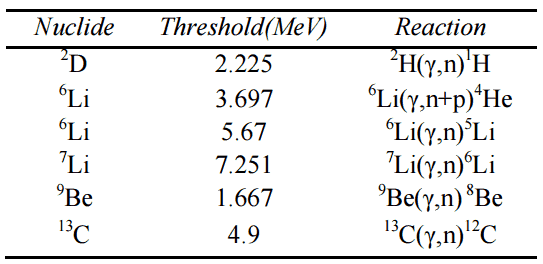Photoneutrons
In nuclear reactors, gamma radiation also plays a significant role in reactor kinetics and subcritical control, especially in nuclear reactors with D2O moderators (CANDU reactors) or Be reflectors (some experimental reactors). Neutrons can also be produced in (γ, n) reactions, and therefore they are usually referred to as photoneutrons.
A high-energy photon (gamma-ray) can, under certain conditions, eject a neutron from a nucleus. It occurs when its energy exceeds the binding energy of the neutron in the nucleus. Most nuclei have binding energies over 6 MeV, above the energy of most gamma rays from fission. On the other hand, few nuclei with sufficiently low binding energy are of practical interest. These are 2D, 9Be, 6Li, 7Li, and 13C. As can be seen from the table, the lowest threshold have 9Be with 1.666 MeV and 2D with 2.226 MeV.

threshold energies.
In the case of deuterium, neutrons can be produced by the interaction of gamma rays (with a minimum energy of 2.22 MeV) with deuterium: Because fission products with certain delays can emit gamma rays. The process is very similar to that through which a “true” delayed neutron is emitted. Photoneutrons are usually treated no differently than regularly delayed neutrons in the kinetic calculations. Photoneutron precursors can also be grouped by their decay constant, similarly to “real” precursors. The table below shows the relative importance of source neutrons in CANDU reactors by showing the makeup of the full power flux.
Because fission products with certain delays can emit gamma rays. The process is very similar to that through which a “true” delayed neutron is emitted. Photoneutrons are usually treated no differently than regularly delayed neutrons in the kinetic calculations. Photoneutron precursors can also be grouped by their decay constant, similarly to “real” precursors. The table below shows the relative importance of source neutrons in CANDU reactors by showing the makeup of the full power flux. Even though photoneutrons are important, especially in CANDU reactors, deuterium nuclei are always present (~0.0156%) in the light water of LWRs. Moreover, the capture of neutrons in the water molecules’ hydrogen nucleus yields small amounts of D2O. This enhances the heavy water concentration. Therefore, in LWRs kinetic calculations, photoneutrons from D2O are treated as additional groups of delayed neutrons with characteristic decay constants λj and effective group fractions.
Even though photoneutrons are important, especially in CANDU reactors, deuterium nuclei are always present (~0.0156%) in the light water of LWRs. Moreover, the capture of neutrons in the water molecules’ hydrogen nucleus yields small amounts of D2O. This enhances the heavy water concentration. Therefore, in LWRs kinetic calculations, photoneutrons from D2O are treated as additional groups of delayed neutrons with characteristic decay constants λj and effective group fractions.
After a nuclear reactor has been operating at full power for some time, there will be a considerable build-up of gamma rays from the fission products. This high gamma flux from short-lived fission products will decrease rapidly after shutdown. In the long term, the photo neutron source decreases with the decay of long-lived fission products that produce delayed high-energy gamma rays, and the photo neutron source drops slowly, decreasing a little each day. The longest-lived fission product with gamma-ray energy above the threshold is 140Ba with a half-life of 12.75 days.
The amount of fission products present in the fuel elements depends on how long the reactor has been operated before shut-down and at which power level has been the reactor operated before shut-down. Photoneutrons are usually a major source in a reactor and ensure sufficient neutron flux on source range detectors when the reactor is subcritical in long-term shutdown.
In comparison with fission neutrons, that make a self-sustaining chain reaction possible, delayed neutrons make reactor control possible and photoneutrons are of importance at low power operation.